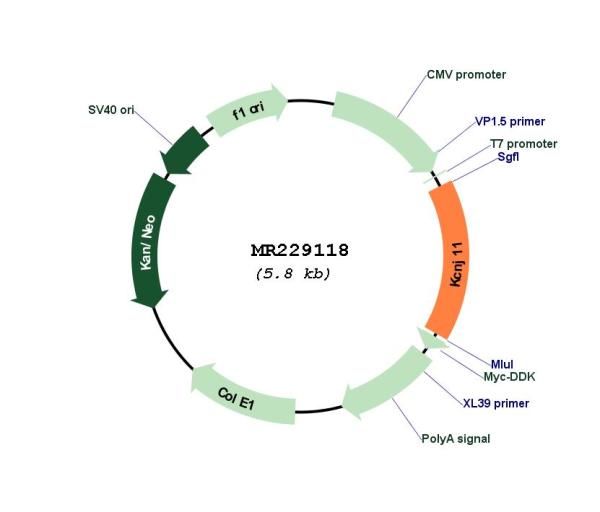Kcnj11 (NM_001204411) Mouse Tagged ORF Clone
CAT#: MR229118
- TrueORF®
Kcnj11 (myc-DDK-tagged) - Mouse potassium inwardly rectifying channel, subfamily J, member 11 (Kcnj11), transcript variant 2
"NM_001204411" in other vectors (1)
Interest in protein/lysate? Submit request here!
USD 198.00
Specifications
| Product Data | |
| Type | Mouse Tagged ORF Clone |
| Tag | Myc-DDK |
| Symbol | Kcnj11 |
| Synonyms | Kir6.2; mBIR |
| Vector | pCMV6-Entry |
| E. coli Selection | Kanamycin (25 ug/mL) |
| Mammalian Cell Selection | Neomycin |
| Sequence Data |
>MR229118 representing NM_001204411
Red=Cloning site Blue=ORF Green=Tags(s) TTTTGTAATACGACTCACTATAGGGCGGCCGGGAATTCGTCGACTGGATCCGGTACCGAGGAGATCTGCC GCCGCGATCGCC ATGGTCTGGTGGCTCATCGCCTTCGCCCACGGTGACCTGGCCCCCGGAGAGGGCACCAATGTGCCCTGCG TCACAAGCATCCACTCCTTTTCATCTGCCTTCCTTTTCTCCATCGAGGTCCAGGTGACCATTGGTTTCGG CGGGCGCATGGTGACAGAGGAATGTCCCCTGGCCATCCTCATTCTCATTGTGCAGAATATCGTCGGGCTG ATGATCAACGCCATCATGCTGGGCTGCATCTTCATGAAAACGGCCCAGGCCCATCGGCGGGCAGAAACCC TCATCTTCAGCAAGCATGCTGTGATCACCCTGCGCCATGGCCGCCTGTGCTTCATGCTGCGCGTAGGGGA CCTCCGAAAGAGCATGATCATTAGCGCCACCATCCACATGCAGGTGGTGCGCAAGACCACCAGCCCCGAG GGCGAAGTTGTGCCTCTCCACCAGGTAGACATCCCCATGGAGAATGGCGTGGGTGGTAACGGCATCTTCC TGGTGGCCCCACTCATCATCTACCACGTCATCGACTCCAACAGCCCGCTCTACGACCTGGCTCCTAGTGA CCTGCACCACCACCAGGACCTGGAGATCATTGTCATCTTGGAAGGCGTGGTAGAAACCACGGGCATCACC ACCCAGGCCCGCACCTCCTACCTAGCTGACGAGATTCTATGGGGGCAGCGCTTTGTCCCCATTGTGGCCG AGGAGGACGGCCGCTATTCTGTGGACTACTCCAAATTTGGTAACACCATTAAAGTGCCCACACCACTCTG CACAGCCCGCCAGCTTGATGAGGACCGCAGTCTGCTGGATGCCCTGACCCTCGCCTCGTCGCGGGGGCCC CTGCGCAAGCGCAGTGTGGCTGTGGCGAAGGCCAAGCCCAAGTTTAGCATCTCTCCAGATTCCTTGTCC ACGCGTACGCGGCCGCTCGAGCAGAAACTCATCTCAGAAGAGGATCTGGCAGCAAATGATATCCTGGATT ACAAGGATGACGACGATAAGGTTTAA >MR229118 representing NM_001204411
Red=Cloning site Green=Tags(s) MVWWLIAFAHGDLAPGEGTNVPCVTSIHSFSSAFLFSIEVQVTIGFGGRMVTEECPLAILILIVQNIVGL MINAIMLGCIFMKTAQAHRRAETLIFSKHAVITLRHGRLCFMLRVGDLRKSMIISATIHMQVVRKTTSPE GEVVPLHQVDIPMENGVGGNGIFLVAPLIIYHVIDSNSPLYDLAPSDLHHHQDLEIIVILEGVVETTGIT TQARTSYLADEILWGQRFVPIVAEEDGRYSVDYSKFGNTIKVPTPLCTARQLDEDRSLLDALTLASSRGP LRKRSVAVAKAKPKFSISPDSLS TRTRPLEQKLISEEDLAANDILDYKDDDDKV |
| Restriction Sites |
SgfI-MluI
Cloning Scheme for this gene
Plasmid Map

|
| ACCN | NM_001204411 |
| ORF Size | 909 bp |
| OTI Disclaimer | The molecular sequence of this clone aligns with the gene accession number as a point of reference only. However, individual transcript sequences of the same gene can differ through naturally occurring variations (e.g. polymorphisms), each with its own valid existence. This clone is substantially in agreement with the reference, but a complete review of all prevailing variants is recommended prior to use. More info |
| OTI Annotation | This clone was engineered to express the complete ORF with an expression tag. Expression varies depending on the nature of the gene. |
| Product Components | The ORF clone is ion-exchange column purified and shipped in a 2D barcoded Matrix tube containing 10ug of transfection-ready, dried plasmid DNA (reconstitute with 100 ul of water). |
| Reconstitution | 1. Centrifuge at 5,000xg for 5min. 2. Carefully open the tube and add 100ul of sterile water to dissolve the DNA. 3. Close the tube and incubate for 10 minutes at room temperature. 4. Briefly vortex the tube and then do a quick spin (less than 5000xg) to concentrate the liquid at the bottom. 5. Store the suspended plasmid at -20°C. The DNA is stable for at least one year from date of shipping when stored at -20°C. |
| Reference Data | |
| RefSeq | NM_001204411.1, NP_001191340.1 |
| RefSeq Size | 2667 bp |
| RefSeq ORF | 912 bp |
| Locus ID | 16514 |
| Cytogenetics | 7 29.66 cM |
| MW | 33.7 kDa |
| Gene Summary | This receptor is controlled by G proteins. Inward rectifier potassium channels are characterized by a greater tendency to allow potassium to flow into the cell rather than out of it. Their voltage dependence is regulated by the concentration of extracellular potassium; as external potassium is raised, the voltage range of the channel opening shifts to more positive voltages. The inward rectification is mainly due to the blockage of outward current by internal magnesium. Can be blocked by extracellular barium. Can form cardiac and smooth muscle-type KATP channels with ABCC9. KCNJ11 forms the channel pore while ABCC9 is required for activation and regulation (By similarity).[UniProtKB/Swiss-Prot Function] |
Documents
| Product Manuals |
| FAQs |
| SDS |
Resources
Other Versions
| SKU | Description | Size | Price |
|---|---|---|---|
| MC226907 | Kcnj11 (untagged) - Mouse potassium inwardly rectifying channel, subfamily J, member 11 (Kcnj11), transcript variant 2 |
USD 330.00 |
{0} Product Review(s)
Be the first one to submit a review






























































































































































































































































 Germany
Germany
 Japan
Japan
 United Kingdom
United Kingdom
 China
China


